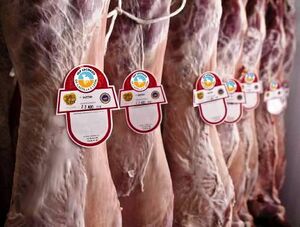Lechazo de Castilla y León (Castilla-León suckling lamb)

IGP Lechazo de Castilla y León is meat from both male and female suckling lambs of the Churro, Castellano and Ojalado breeds. The meat is pearly white or pale pink and very tender, with little intramuscular fat. It is very succulent and has a very smooth texture.
Geographical area: The production area comprises various agricultural districts in the Autonomous Community of Castilla y Leön. Slaughtering and dressing take place throughout Castilla y Leön.
Proof of origin: The factors which prove that Lechazo de Castilla y Leön originates in the area are as follows:
The carcasses are those of lambs from farms registered with the Regulatory Board. The sheep farms are situated in the production area indicated and the lambs must be born and reared on those farms.
The lambs are identified at birth with a tag on their left ear.
Slaughter and dressing are carried out in slaughterhouses and cutting and packing rooms entered in the Regulatory Board’s industrial register.
The Board, via the Carcass Classification Committee, decides whether carcasses qualify for the IGP.
Method of production: The carcasses are those of lambs of the Churro, Castellano and Ojalado breeds. They are fed exclusively on their mother’s milk. Animals accepted for the IGP are slaughtered on the day they enter the slaughterhouse, always within ten hours of arrival and apart from other animals. The carcasses are hung in rooms at 4C until the day after slaughter, and then stored in chill rooms at 1C for not more than five days. They must be marketed not more than eight days after slaughter.
Link: The production area coincides with the mixed sheep/cereal farming areas, with cereals being supplemented by natural grazing and stubble in the feed, where the breeds in question determine the quality of the suckling lamb.
Gastronomy: IGP meat can be stored in refrigerator for a few days, wrapped with protection film, in the coolest compartment. It is very good when cooked or roasted with recipes from the Castilian culinary tradition. It can be combined with other ingredients like ham, mushrooms and pine-kernels to prepare exquisite dishes flavoured with a bit of wine or port or a small spoon of rosemary honey; all this accompanied by a risotto or roasted potatoes.
Reference: The European Commission
#lambs #roasted #honey #mushrooms #refrigerator #cereals #risotto #roastpotatoes #fat #port #wine